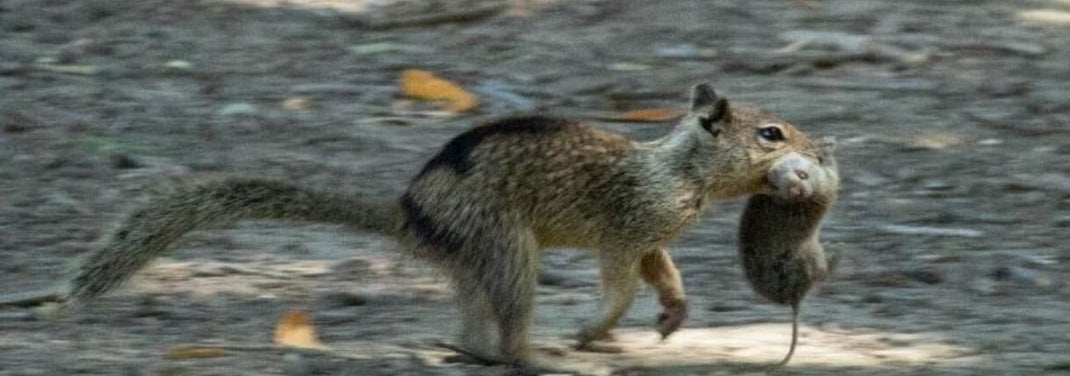Contribution from the western corner of Pulaski County. Edited by SPA Staff

A California ground squirrel in Contra Costa County runs with a vole it hunted in its mouth. A study from UC Davis and University of Wisconsin-Eau Claire is the first to document widespread carnivorous feeding of voles by squirrels. (Sonja Wild, UC Davis)
Every summer morning, the same scene plays out beneath the nut trees in my front yard. A few ground squirrels appear like clockwork, rustling through the leaves, digging with those nimble little paws, and eventually making their way onto the porch to nibble whatever they’ve gathered. For years, I thought little of them, cute, destructive, scrappy little foragers that seem more interested in acorns than anything else.
But this morning’s events caused me to change from seeing them as sweet little rascals to vicious killers in disguise!
Just after daybreak, I heard the buzz of a jar fly, odd for that early. I looked outside to see one of “my” squirrels eating it. Not just pawing at it, eating it. That unsettling sight sent me down a rabbit hole (or squirrel burrow, if you will), leading me straight to something I never expected: squirrels aren’t just innocent nut hoarders. They’re hunters. And not just occasionally—strategically.
In a groundbreaking 2024 study published in the Journal of Ethology and reported by the Smithsonian Magazine, researchers in California documented ground squirrels, yes, those seemingly docile burrowers, actively hunting small mammals. At Briones Regional Park, just outside San Francisco, scientists observed 74 squirrel-vole encounters over an eight-week stretch. In nearly half of those cases, the squirrels didn’t just scavenge, they stalked, pounced, and killed their prey, sometimes with brutal efficiency: neck-biting, decapitation, and all (Smithsonian magazine).
So, what does this have to do with Southern Kentucky?
Everything.
Warning: If you are triggered by wildlife doing wildlife things, don't watch the video.
Vole hunting: Novel predatory and carnivorous behavior by California ground squirrels. Copyright Team Squirrel, Wisconsin-Eau Claire, UC Davis
Sonja Wilds December 18, 2024
A few years ago, we had chickens, and not surprisingly I would find a dead chicken in the coop now and then. Sometimes they would be decapitated or have only their neck removed. I blamed racoons until I caught a tiny opossum in the coop chowing down on contents from a crop of one of our beloved Orpingtons. Soon after, one of my chicken buddies told me that it was not unusual.
Several days ago, another friend found several of his chicks missing. So this story made me wonder, could squirrels be the culprits when chicks go missing, when duck and chicken nests are raided? We tend to blame the usual suspects: raccoons, weasels, opossums, and neighborhood dogs. But maybe it’s time to look a little closer at the critters we’ve dismissed as harmless.
In parts of the Midwest, other ground squirrel species, like the thirteen-lined ground squirrel and white-tailed antelope squirrel, have also shown signs of omnivory. Stomach content studies have revealed everything from shrew remains to bird flesh. These behaviors have mostly been viewed as incidental, or at worst, desperate (Smithsonian magazine).
But if what happened in California is the beginning of a broader behavioral trend, it’s worth asking: what else don’t we know?
Because if squirrels are chasing down voles in California parks, who’s to say they aren’t going after chicks in Southern Kentucky henhouses?
Maybe they have always been this extreme, but maybe it is increased food competition, and the rural sprawl, or dare I say, climate change, pushing wildlife to adapt in strange, sometimes unsettling ways. I heard a podcaster say the other day that after the Great Depression animals like deer, groundhog, squirrels, beaver, and such faced a great decline. I can see where this could be true. My grandparents wasted nothing they caught stealing from the garden. Except turtles. Turtles were allowed to go on their way, unharmed. But now, it seems wildlife has bounced back to the point where deer and rabbits come up to the edge of the porch in the evenings when we are outside. They have zero fear. It wasn’t this way a few short decades ago.
We may not have peer-reviewed footage from Pulaski County just yet, but maybe it’s time we start watching our yards a little more closely. That squirrel sitting on your fence post? He might not be waiting for acorns. He could be hunting.
So next time you hear rustling in the coop or spot scattered feathers without clear footprints, ask yourself a couple of things:
What’s really killing your chickens? and What else are these cute little monsters capable of?